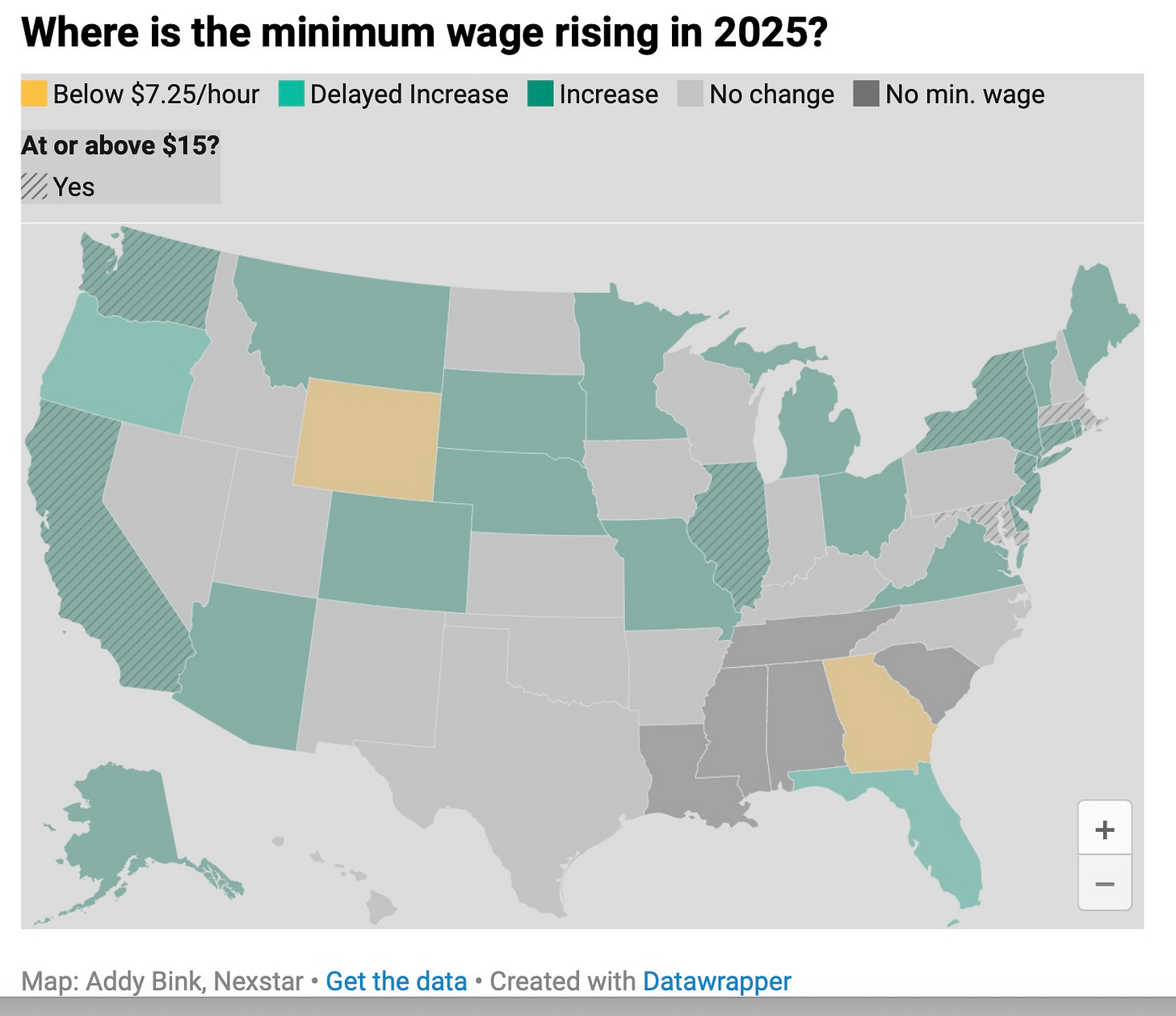Welcome to The Poverty Trap, a newsletter and podcast for people who are fed up with the inequality baked into America’s system and want to collectively make change.
__________________________________________
State Minimum Wages Play A Part: Millions of American Workers Are Not Earning Enough To Afford Any Kind Of Housing.
“Twenty states have a minimum hourly wage of $7.25, the federal rate that hasn't been changed since 2009. But lawmakers and voters in dozens of states have set higher minimum wages. Here are the current rates as of Jan. 1, 2025.” U.S. Department of Labor

_____________________________________
We know that homelessness stands adjacent to poverty, ever-present in the lives of at least 40 million Americans who live paycheck-to paycheck, primarily out of necessity rather than budgeting choices. This figure overlaps with those millions of Americans who live at or below the federal poverty line, estimated at the end of 2023 to be close to 37 million people, including those working part-time or who are unemployed. I’ve written about the homeless crisis in the United States several times, including over a year ago when the prevalence of folks living in their cars (euphemistically dubbed ‘vehicle residency”) began an uptick.
Jeremy Ney, author of
has written numerous times about the homeless crisis, most recently early this year when he published a post analyzing the 2024 HUD statistics that documented the recent rise in homelessness, the likely causes for the spike, and specific strategies to decrease the homeless population. These posts, their sources and statistics provide a solid background to better understand why homelessness is continuing to increase in the United States and the possible strategies to reverse this trend.In 2018, the National Institute of Health (NIH) published as part of a larger study, a summary titled, “The History of Homelessness in the United States” that provides an interesting, chronological narrative of how our definitions and cultural notions of homelessness changed, from “tramps” and “hobos” in the late 1800’s through the HIV/AIDS epidemic and President Obama’s study and resulting written plan published in 2017, to end homelessness in the United States.
Adding to these statistics and analysis on homelessness, and perhaps more importantly, reframing them a bit, is an opinion piece recently published in The New York Times titled: “America Is Pushing Its Workers Into Homelessness”, by Brian Goldstone, who is also the author of the forthcoming book: “There Is No Place for Us: Working and Homeless In America”.
Although his book is not out yet, Goldstone’s guest essay in The Times gives us a good idea of its theme: it is our system (and I’ll say “our system ‘rigged’ in favor of the wealthy and against the poor) that is literally pushing people into poverty and homelessness. What he says here is telling:
For decades, lawmakers have stood by while rents soared, while housing was turned into an asset class for the wealthy, while worker protections were shredded and wages failed to keep up. The NY Times Opinion piece, Brian Goldstone, March 1, 2025.
Housing as “an asset class for the wealthy”. That statement is as shocking as ‘the working homeless”. We’re not just allowing, but incentivizing big business and wealthy individuals to take over any affordable housing that already exists (think Blackstone buying hundreds of thousands of what used to be starter homes and apartment buildings, then renting them at jacked-up prices). Read all about Blackstone’s profits made on the backs of the poor in California and beyond, here.
Yes, there is a severe lack of affordable housing in the United States, but what does affordable mean when you are working 40 hours a week at $7.25 an hour ($15,080 a year, gross—poverty level), or at the highest minimum wage in the country in Washington state of $16.66 an hour ($34,654 a year, gross—still barely scraping by even for one person, but well above earning caps for government assistance).1
According to a recent, National Low Income Housing Coalition report cited in Goldstone’s essay, there isn’t a single state, city or county in the country where working a full-time, minimum wage job will allow you to rent a mid-priced, two bedroom apartment. For that privilege, one would have to earn $32.11 an hour. By the way, the spike in rent prices far exceed any wage increases in the last four decades. In fact, according to testimony presented before Congress by Mathew Desmond, Pulitzer prize-winning author of Evicted and Poverty By America on behalf of the Eviction Lab at Princeton University, “rent prices have exceeded income gains by 325 percent” since 1985.
Do you see the number of studies and government and private sector reports on homelessness I’ve mentioned here —and these few are just the tip of the iceberg. Well-intentioned people are doing a lot of talking, surveying and report writing without generating much concrete action, it seems. Although some laws and policies have been implemented over the years, these apparently haven’t had much of an impact because the homeless population in the richest country on earth is growing.
And people are suffering. Just last month, two young children in Detroit died of carbon monoxide poisoning while their parents’ van was parked in a casino garage. The family was homeless, and according to the AP article: “The children’s mother had called the city on Nov. 25 to say their temporary housing was about to end, but no one followed up and she didn’t call back, [Detroit] Mayor Mike Duggan said.”
Goldstone’s essay also discusses, perhaps most significantly, what he believes contributes to the current misunderstanding of our homeless population, including the purposeful shaping of our national narrative about the homeless, starting with studies commissioned during the Reagan administration. A review of these studies decades later shows that the responsibility for the growing homeless population was shifted to the homeless themselves (they were mentally ill, abused alcohol and drugs, were just plain lazy), rather than the social structure designed by our elected officials, like the slashing of federal programs to help the poor, as just one example. As Goldstone says, the cruelty of cutting money to social programs is a lot easier to justify when it’s the recipients who are to blame. This is what I mean when I’ve repeatedly said that our culture surrounding poverty has to change. We need to “think different” about the poor and change our policies accordingly.
_______________________________________________
Let me know what you think about our growing homeless population and what actions our elected officials, or others, should take to end this national embarrassment and suffering. Please leave your thoughts in the Comment Section below.
This post goes out to both free and paid subscribers, but if you are not already a paid subscriber and value this effort and our growing community, please consider upgrading to a paid membership. Thank you! And a hearty “thank you” to my latest free and paid subscribers—I appreciate your support!












Share this post